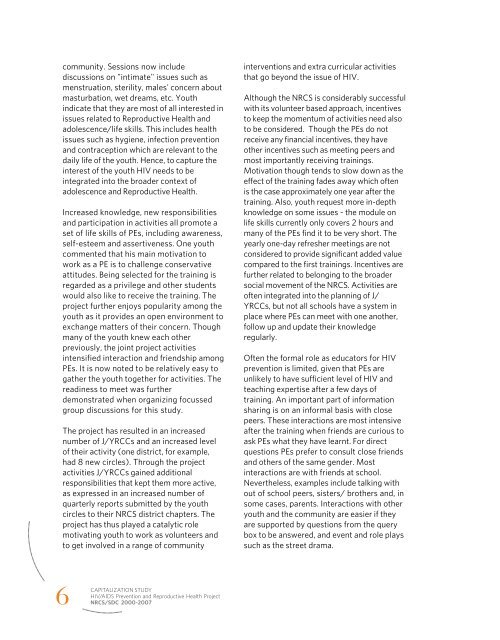HIV/AIDS Prevention & Reproductive Health Project
HIV/AIDS Prevention & Reproductive Health Project
HIV/AIDS Prevention & Reproductive Health Project
You also want an ePaper? Increase the reach of your titles
YUMPU automatically turns print PDFs into web optimized ePapers that Google loves.
community. Sessions now include<br />
discussions on "intimate" issues such as<br />
menstruation, sterility, males' concern about<br />
masturbation, wet dreams, etc. Youth<br />
indicate that they are most of all interested in<br />
issues related to <strong>Reproductive</strong> <strong>Health</strong> and<br />
adolescence/life skills. This includes health<br />
issues such as hygiene, infection prevention<br />
and contraception which are relevant to the<br />
daily life of the youth. Hence, to capture the<br />
interest of the youth <strong>HIV</strong> needs to be<br />
integrated into the broader context of<br />
adolescence and <strong>Reproductive</strong> <strong>Health</strong>.<br />
Increased knowledge, new responsibilities<br />
and participation in activities all promote a<br />
set of life skills of PEs, including awareness,<br />
self-esteem and assertiveness. One youth<br />
commented that his main motivation to<br />
work as a PE is to challenge conservative<br />
attitudes. Being selected for the training is<br />
regarded as a privilege and other students<br />
would also like to receive the training. The<br />
project further enjoys popularity among the<br />
youth as it provides an open environment to<br />
exchange matters of their concern. Though<br />
many of the youth knew each other<br />
previously, the joint project activities<br />
intensified interaction and friendship among<br />
PEs. It is now noted to be relatively easy to<br />
gather the youth together for activities. The<br />
readiness to meet was further<br />
demonstrated when organizing focussed<br />
group discussions for this study.<br />
The project has resulted in an increased<br />
number of J/YRCCs and an increased level<br />
of their activity (one district, for example,<br />
had 8 new circles). Through the project<br />
activities J/YRCCs gained additional<br />
responsibilities that kept them more active,<br />
as expressed in an increased number of<br />
quarterly reports submitted by the youth<br />
circles to their NRCS district chapters. The<br />
project has thus played a catalytic role<br />
motivating youth to work as volunteers and<br />
to get involved in a range of community<br />
interventions and extra curricular activities<br />
that go beyond the issue of <strong>HIV</strong>.<br />
Although the NRCS is considerably successful<br />
with its volunteer based approach, incentives<br />
to keep the momentum of activities need also<br />
to be considered. Though the PEs do not<br />
receive any financial incentives, they have<br />
other incentives such as meeting peers and<br />
most importantly receiving trainings.<br />
Motivation though tends to slow down as the<br />
effect of the training fades away which often<br />
is the case approximately one year after the<br />
training. Also, youth request more in-depth<br />
knowledge on some issues - the module on<br />
life skills currently only covers 2 hours and<br />
many of the PEs find it to be very short. The<br />
yearly one-day refresher meetings are not<br />
considered to provide significant added value<br />
compared to the first trainings. Incentives are<br />
further related to belonging to the broader<br />
social movement of the NRCS. Activities are<br />
often integrated into the planning of J/<br />
YRCCs, but not all schools have a system in<br />
place where PEs can meet with one another,<br />
follow up and update their knowledge<br />
regularly.<br />
Often the formal role as educators for <strong>HIV</strong><br />
prevention is limited, given that PEs are<br />
unlikely to have sufficient level of <strong>HIV</strong> and<br />
teaching expertise after a few days of<br />
training. An important part of information<br />
sharing is on an informal basis with close<br />
peers. These interactions are most intensive<br />
after the training when friends are curious to<br />
ask PEs what they have learnt. For direct<br />
questions PEs prefer to consult close friends<br />
and others of the same gender. Most<br />
interactions are with friends at school.<br />
Nevertheless, examples include talking with<br />
out of school peers, sisters/ brothers and, in<br />
some cases, parents. Interactions with other<br />
youth and the community are easier if they<br />
are supported by questions from the query<br />
box to be answered, and event and role plays<br />
such as the street drama.<br />
6<br />
CAPITALIZATION STUDY<br />
<strong>HIV</strong>/<strong>AIDS</strong> <strong>Prevention</strong> and <strong>Reproductive</strong> <strong>Health</strong> <strong>Project</strong><br />
NRCS/SDC 2000-2007

















